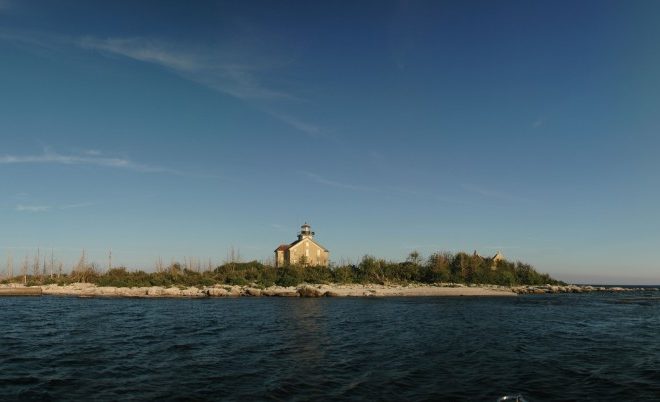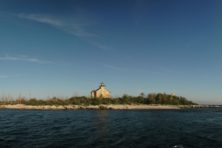Feds Say Pilot Island Will Remain a Colonial Nesting Area
- Share
- Tweet
- Pin
- Share

But USFWS will look into assessing impact that birds have on fish
Members of the Washington Island Sportsman’s Club voiced their dissatisfaction over the current use of Pilot Island as a migratory bird nesting area during a March 1 meeting with the U.S. Fish and Wildlife Service (USFWS) that lasted nearly three hours.
“I think we have a cormorant problem there, and I just hope we can do something about it,” said club president Martin Andersen.
The club wants the USFWS to restore the 3.5-acre island off the tip of the Door peninsula as it existed decades ago and no longer use it as a colonial bird sanctuary for cormorants and other migratory birds.
USFWS project leader Bill Peterson, who has oversight of the Green Bay National Wildlife Refuge, where Pilot Island is located, told the club members at the Washington Island Community Center’s Rutledge Room, and others joining the meeting remotely, that the island would remain a colonial nesting area for birds, even if cormorants were removed.
“Initially, we wouldn’t have cormorants, but we would still have gulls and all the [other] birds, and it would still remain closed to the public,” he said. “We don’t have any of those remote islands that raccoons and coyotes can’t get to that aren’t occupied by some sort of colonial nesting bird.”
The USFWS figures the island’s cormorant population was around 9,765 in 2021, based on 3,756 nests there during the most recent count and each nest calculated to represent 2.6 birds.
The club has characterized Pilot Island as having turned into a “smelly, polluted eyesore.” The Door County Board of Supervisors also focused on the degraded water quality surrounding the island when it passed a resolution Feb. 24 that asked the USFWS to remediate and remove the future negative impact of the birds residing on the island.
Peterson acknowledged that the water quality around Pilot Island is affected by the number of birds, but he said divers should understand that there may be times during the nesting season when it may not be safe to swim near the shipwrecks by the island.
“It should be intuitive when people get close to an island and see that many birds, especially if you had a rain, that you should not swim downstream from it,” he said. “Pilot [Island] is not open to the public. It’s not going to be open to the general public the way Plum [Island] is, and so it’s not a destination for swimming.”
Water sampling that the University of Wisconsin-Oshkosh conducted around Pilot Island found elevated levels of E. coli bacteria, said club member Hoyt Purinton, and the USFWS has a “duty to inform” people about the water quality there.
Peterson said the elevated E. coli levels are “restricted to a relatively small area of contaminated water around the island, and it dilutes. It’s not a health-safety issue by the time you make it to [Washington Island].”
Neither is runoff from having colonial nesting birds on Pilot Island a violation of the Clean Water Act.
“We’re talking about a relatively remote island,” Peterson said.
Purinton, who took exception with there being no limit on the number of cormorants allowed on Pilot Island, characterized the USFWS’s management of the island as a “blight on the agency.”
“We literally and figuratively hold our nose because of Pilot island,” he said.
Purinton said the cormorants were having a negative impact on the local fish population and asked the USFWS to establish “some sort of science before making decisions.” Club member Dan Nilsson said he has never seen the fishing on Washington Island during the past 70 years as poor as it is now.
“It’s a terrible situation, and I’m trying to protect our future generations that are growing up to be able to go fishing,” he said. “I’m trying to have them enjoy recreation, being outside in fresh air, fresh water, which Pilot Island does not provide.”
Peterson said it “would be good to have more information,” and he would ask the USFWS to seek additional research, such as from the Wisconsin Department of Natural Resources.
“If the proposal were to reduce cormorant numbers – hypothetical, just pick whatever you want with cormorant numbers at Pilot [Island] – I have to have a rationale for doing so that is defensible and is not arbitrary and capricious,” he said.
Peterson said he would look into the cost of a cormorant study.
Purinton said the club has contacted U.S. Rep. Mike Gallagher’s office regarding Pilot Island and “won’t give up until there’s policy change.”
“No other federal agency has a greater negative impact on this community than [the U.S.] Fish and Wildlife Service,” he said. “I’m sorry to say it that way, and you need to recognize that, and our request is an immediate change in course.”
What Advocates Want for Pilot Island
An online petition drive posted on savepilotisland.com calls for the following “immediate actions”:
- Remove the cormorants.
- Preserve and restore the lighthouse keeper’s building to its original state.
- Reconstruct the fog-signal building to its original state.
- Remove the cormorant guano; replace it with fertile soil, flora and trees; and return the land to its original state.
- Build a dock and boat channel so visitors can safely access the island.


